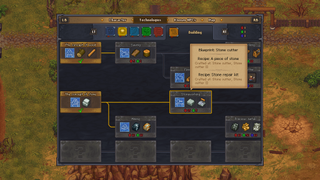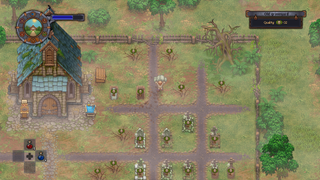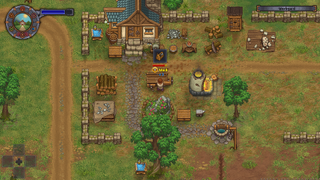My first 20 hours of Graveyard Keeper felt like purgatory
And yet I just can't stop playing.

In some freak accident of time travel I seem to have found myself in ye olde medieval times, and I've fallen into the role of proprietor of some town’s graveyard. It's seen better days. I’m given my first directions by, naturally, a disembodied talking skull. But I've played the part of an outsider tasked with reinvigorating an abandoned property before, so I don’t plan to ignore the big farm sim-shaped elephant in the room.
If first looks could kill
If you’re looking for Stardew Graveyard, you’ll find it only partially incarnated here.
My first order of business is repairing my dilapidated graveyard. The grave markers are falling over and little stone fences crumbling to bits. To fix the graves I need wood repair kits. To craft wood repair kits I need nails, which are crafted at an anvil, which I’ll need simple iron parts in order to build. Oh, and the iron parts are made at a smelter which of course I need to have iron parts to build! Welcome to Graveyard Keeper.
I spend my first two hours digging further and further into the resource rabbit hole, which feels like could have been avoided if one of my new neighbors would lend me a damn cup of sugar and some ever-elusive simple iron parts. I finally scrounge together the cash to just buy some from the local blacksmith. Later, I discover that chopping up the broken-looking buckets in my own cellar would have netted me at least some of the parts I needed.

I manage to repeat the same mistake several times over the next several hours: buying or crafting supplies that might have been more within my reach if I’d finished an NPCs quest or explored more diligently. Although this is partly my own ineptitude, I find the sheer number of avenues available in Graveyard Keeper, all of which tendril out into lengthy tech trees, at fault as well.
My new friend the talking skull now wants a bottle of wine before he helps me further. Do I grind out the technology points needed to make my own wine? Find a way to garner additional friendship with the barkeep so he’ll sell me some? Or will one of the locals decide to just throw a bottle my way as a reward? I haven’t yet figured it out, but I’m prepared to go about it the hard way and only find out what I was supposed to have done later on.
Right out of the gate I was vaguely pointed in the right direction to progress, but every new NPC I spoke to would propose their own errand and the rewards were often unclear. Whose random task might earn me a bit of traction in my growing list of woodworking equipment to build?
Jack of too many trades
Graveyard Keeper's crafting and questing in a village setting demand comparison with games like Stardew Valley and My Time At Portia, despite its macabre tone and shifted setting. Instead of farming (though you do have a small garden on your land for growing crops), Graveyard Keeper’s main objective is of course rebuilding and running a successful medieval graveyard. Aside from the resource management and crafting, Graveyard Keeper ditches the more social and character-based elements of other life sims. If you’re looking for Stardew Graveyard, you’ll find it only partially incarnated here.
The biggest gaming news, reviews and hardware deals
Keep up to date with the most important stories and the best deals, as picked by the PC Gamer team.
Daily tasks in Graveyard Keeper range from the familiar cutting trees and mining ores, to writing new sermons to perform in the church, to disemboweling and studying corpses. Tasks require energy, which can be regained by sleeping, though running out of energy has no consequences and you’re free to stay awake for days if you want. Progression is driven by unlocking crafting recipes in a number of technology trees for each of the main vocational skills in the game, allowing you to build crafting stations like a carpenter’s workbench and anvil, but also embalming tables and alchemy racks.

Unlike Stardew Valley, in which any profession can potentially carry you through the game, Graveyard Keeper demands that you give equal attention to each of the many disciplines as failing to progress one will likely block you from pursuing others effectively. You’ll need to have unlocked high level Building blueprints and workstations in order to properly build advanced components to your Church, for instance.
It’s a juggling act in which you’re required to keep every ball in the air. I wouldn’t mind the challenge nearly as much if I were given a friendly nudge in the right direction. With a more defined quest order, perhaps provided by my friend the talking skull, I would feel less frustrated by the time I spent stubbornly blazing my own path—then at least I’d have done it knowingly.
Can anybody hear me?
Compared to Stardew Valley and My Time At Portia, which each spend a good amount of time encouraging you to pursue friendships and relationships with NPCs, Graveyard Keeper feels almost clinical. Its characters are amusing, certainly. There’s a donkey with an Eastern European accent possibly in need of a labor union, a vain Bishop equipped with his own pocket mirror, and plenty more.
Where other life and town simulations often include gift-giving and cutscenes diving into the personality and backstory of each villager, Graveyard Keeper features a dispassionate smile meter for each character. The depth of personality exhibited by each NPC is surface level, a sort of rote line recital that reminds me of a pull-string toy with five total pre-recorded sayings.

I’ve felt an equal inability to leave my mark on my own territory, let alone the town at large. My slowly-expanding front yard has become a sloppy assortment of crafting stations that looks suspiciously similar to the lawn of a rural hoarder. My graveyard looks nice enough, though that’s largely incidental. It just so happens the grave markings that most improve the quality of my property are the nicest-looking. Everything I do in Graveyard Keeper is chosen for its practicality, with no thought spared for aesthetics. Crafting stations and grave decor are either functional or useless, with no room for individual taste in the middle.
No rest for the wicked
I wanted Graveyard Keeper to feel personal in some way. Without customizing the appearance of my character, investing in the story of any NPCs, or being invited to turn my property into anything more than an appliance dumping ground, I feel like my graveyard will end up awfully similar to anyone else’s. It checks all the boxes: crafting, gathering, and a seemingly endless hunt for resources. What it lacks is anything that allows me to make my graveyard uniquely my own.
Graveyard Keeper is ultimately a utilitarian approach to town and life simulation. NPCs are more dispensers of quests and rewards than they are friends. The town itself is a series of areas that slowly become accessible as your crafting prowess increases, but not a place it seems I’m meant to care about. I have plenty of complaints, but despite all of them I still hear that siren song I’ve been lured by before: “Just one more day. One more day, and maybe I’ll finally be able to build that circular saw.”
For more on Graveyard Keeper, check out our diary Graveyard Keeper turned me into the most evil character I've ever played.

Lauren has been writing for PC Gamer since she went hunting for the cryptid Dark Souls fashion police in 2017. She accepted her role as Associate Editor in 2021, now serving as self-appointed chief cozy games and farmlife sim enjoyer. Her career originally began in game development and she remains fascinated by how games tick in the modding and speedrunning scenes. She likes long fantasy books, longer RPGs, can't stop playing co-op survival crafting games, and has spent a number of hours she refuses to count building houses in The Sims games for over 20 years.
Most Popular

